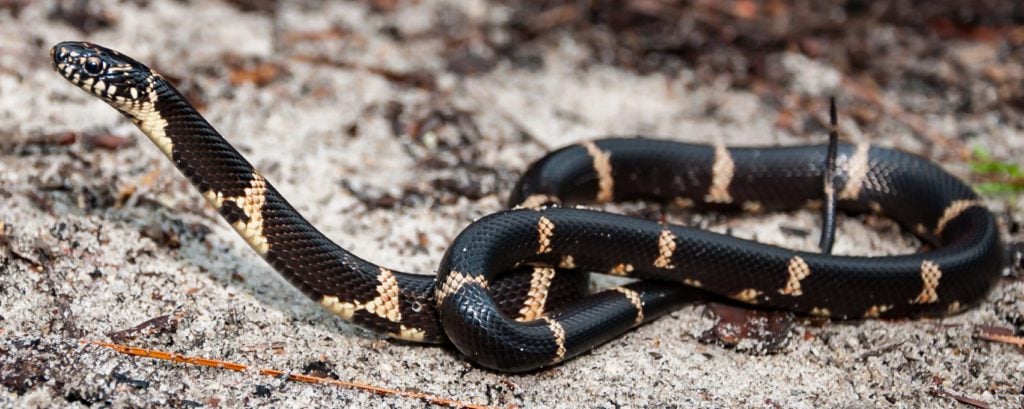3 Types of Kingsnakes in Arizona! (ID Guide)
Finding kingsnakes in Arizona can be difficult!

Here’s why:
Most members of the genus Lampropeltis (kingsnakes) spend a lot of their time hidden beneath objects or underground. So while it’s not unheard of, it’s not very common to just stroll past one while walking outside.
Regardless, these non-venomous, mostly docile snakes are fascinating. For example, did you know that kingsnakes EAT venomous snakes? Believe it or not, it’s true!
Today, you’re going to learn about the 3 types of kingsnakes in Arizona!
-
RELATED: The 27 Types of SNAKES That Live in Arizona! (ID Guide)
-
RELATED: The 41 Types of Lizards Found in Arizona! (With Photos)
#1. California Kingsnake
- Lampropeltis californiae

Identifying Characteristics:
- Adults range from 36 to 48 inches in length.
- Most individuals are black or brown, with whitish bands running down their bodies.
The California Kingsnake is widespread across many types of habitats in Arizona.
Look for them in woodlands, grasslands, deserts, marshes, and even suburban areas! Most of the year, these kingsnakes are found out during the day, except during cold weather when they retreat underground to enter a hibernation-like state called brumation.
California Kingsnake Range Map

Do you know how kingsnakes got the name “king?”
It refers to their ability to hunt down and eat other snakes! Incredibly, California Kingsnakes will even go after venomous rattlesnakes.

This species has the incredible adaptation to constrict its prey. In fact, California Kingsnakes have the strongest squeeze when compared to the size of their body! It’s thought they evolved this trait since their main diet consists of other reptiles, which don’t require as much oxygen as mammals.
#2. Sonoran Mountain Kingsnake
- Lampropeltis pyromelana

Identifying Characteristics:
- Adults reach up to 36 inches in length.
- Coloration is red, black, and yellow, white, or cream bands with the black bands bordering the red.
- The head is white with a black band over the eyes.
These kingsnakes are primarily found in mountainous areas in Arizona, with elevations between 3000 and 9000 feet above sea level. They occupy chaparral, conifer forests, juniper woodlands, and rocky areas and are frequently spotted along streams or near springs.

Sonoran Mountain Kingsnakes are very secretive and often spend their days under rocks, logs, or in dense clumps of vegetation. They hunt at night, and like other kingsnakes, this species is a powerful constrictor. Lizards, birds, rodents, and other small snakes make up the majority of their diet.
Despite their mimicry of coral snakes, Sonoran Mountain Kingsnakes are NOT venomous!
So how do you tell the difference between a dangerous coral snake and a harmless Sonoran Mountain Kingsnake in Arizona?

Just remember this rhyme and you’ll never have to worry! “If red touches yellow, you’re a dead fellow; if red touches black, you’re all right, Jack.”
Interestingly, they sometimes eat venomous snakes since they are immune to pit viper venom! But this doesn’t happen incredibly often because they generally prefer smaller prey.
#3. Desert Kingsnake
- Lampropeltis splendida

Identifying Characteristics:
- Adults typically range from 36 to 48 inches.
- Coloration is glossy black or very dark brown.
- Off-white or yellow speckles form dimly defined narrow cross bands with rectangles of black in between.
Despite its name, Desert Kingsnakes are almost always found in Arizona near WATER. Look for them in riparian corridors and near stock tanks in arid areas.
Like other kingsnakes, this species is a powerful constrictor. They’ll feed on rodents, lizards, and other snakes, including rattlesnakes. In addition, their incredible sense of smell enables them to locate and consume reptile eggs below the surface.
This snake is non-venomous and generally very docile. Interestingly, If confronted, they frequently flip over and play dead!
Do you need additional help identifying a snake?
Try this field guide!
Which of these kingsnakes have you seen before in Arizona?
Leave a comment below!

